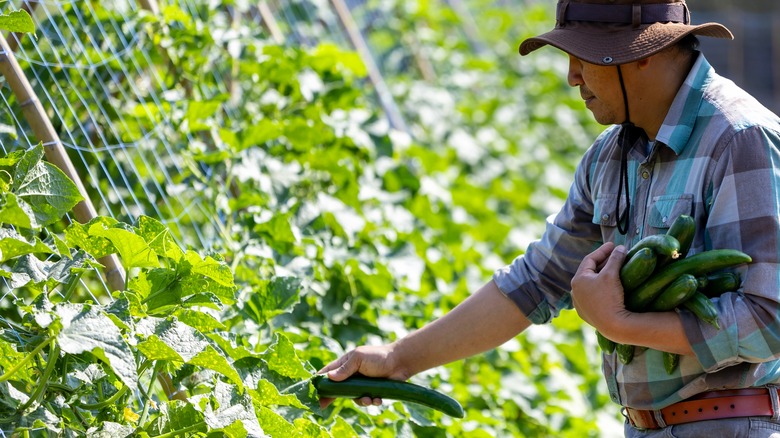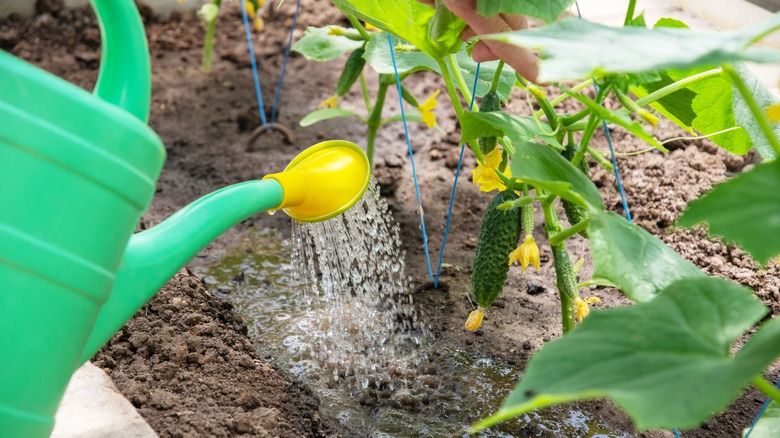This Is The Key To Growing Crisp Cucumber Plants During A Hot Summer
How many cucumbers can come from a plant with the right conditions? After putting all that work into germinating cucumber seeds and nurturing budding plants, building a trellis, and perfecting your compost game, you expected an abundant crop. Instead, you've ended up with misshapen, tasteless (or bitter), crunch-less cucumbers. What you're getting is the result of water stress. Healthy cucumber plants produce crisp fruit, and keeping the vines in tip-top condition means getting the watering right — that is, providing lots of it. After all, cucumbers, the fruit, are over 90 percent water. In practice, this looks like watering daily (sometimes twice a day), deeply, and on a set schedule, and regularly checking soil to see if the amount of water you're providing needs adjusting.
Science backs up the relationship between adequate water and a healthy, crispy cucumber. A 1993 study in the Journal of the American Society for Horticultural Science found restricted watering hinders cucumber plant photosynthesis, while a 2010 paper in the Fresenius Environmental Bulletin revealed that water stress (due to lower levels of water than optimal) affects the production of macronutrients and essential building blocks, like sugars and starches. Likewise, a 2020 Agronomy article showed reduced watering inhibits the development of nutrients like malic acid, carotenoids, and minerals and trace elements like iron and zinc in the fruit. Research from the Journal of Arid Environments (1980) confirmed that, perhaps unsurprisingly, a lot more water is needed to grow healthy cucumber plants and, therefore, crunchy fruit, in high temperatures.
Stick to a strict watering schedule for crunchy cucumbers
Cucumber plants have a shallow root system, meaning they're unlikely to feature on any list of drought-tolerant vegetables to add to your garden. Plus, adequate watering is crucial for flower and fruit development. Aim for at least 1 inch of water weekly. If summer temperatures rise above 90 degrees Fahrenheit, switch to every one to two days. Water on a strict schedule — cucumbers are sticklers for consistency. If your soil is sandy, water two times per week, and trellised cucumbers may also require more water. Soak that soil to a depth of anywhere between 6 and 12 inches, and water in the morning to reduce the potential for waterborne diseases on leaves and stems.
Regularly test your soil to see how well it's retaining the water you're pouring into it. The easiest way to do this is to stick your finger or a long Phillips head screwdriver into the soil right at the base of the cucumber's stem. If the dirt feels dry to the touch, or if there's no soil stuck to the end of the screwdriver, it's a good indicator you need to water. Alternatively, roll a bit of soil into a ball. If it's firm and not sticky or crumbly, the soil is sufficiently moist. Of course, for the greatest accuracy, insert a moisture gauge up to 4 inches into the soil. The ideal you're aiming for is no less than 65 percent of the soil's total water-holding capacity.
Soaker irrigation or sprinkler: What's the best way to water cucumber plants?
For ultimate snappy-ness, install drip or soaker irrigation, use a watering can (hand watering helps you keep track of exactly how much you're giving the plants), or water deeply with a garden hose. Avoid sprinklers or anything that waters the plant's leaves. A layer of the best type of mulch for your garden reduces evaporation, keeping your plant's roots uniformly damp all day long. Watering with chlorinated water might also have some effect on a cuc's crispiness. If you have the ability to do so, capture rainwater — either in a barrel or simply just buckets placed around your garden — and use that to water your plants.
Watering container-grown cucumbers requires a special approach. Focus on bush rather than vining cultivars, and place the pots somewhere sunny but near a water source; make watering as easy as possible. In order to keep a plant's stems and leaves dry, pour water into the pot's saucer. Alternatively, opt for self-watering planters, which feature a reservoir of water in the bottom of the pot the plant's roots can draw from throughout the day. If you notice a gap between the soil and the planter walls, the soil is too dry. Mulch works here, too. Fill the top of your planters with moisture-trapping layers of organic material to stop the plant's roots from drying out. Don't let drainage holes get blocked. Cucumbers are as susceptible to overwatering as they are under-watering.

